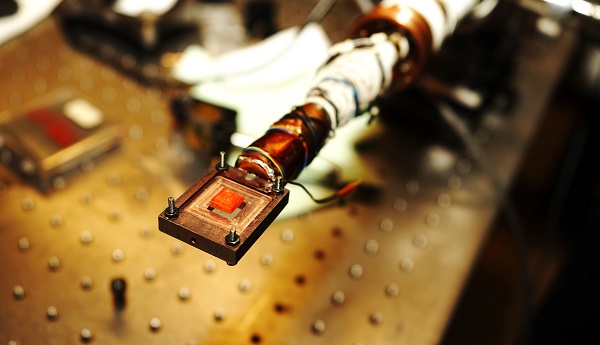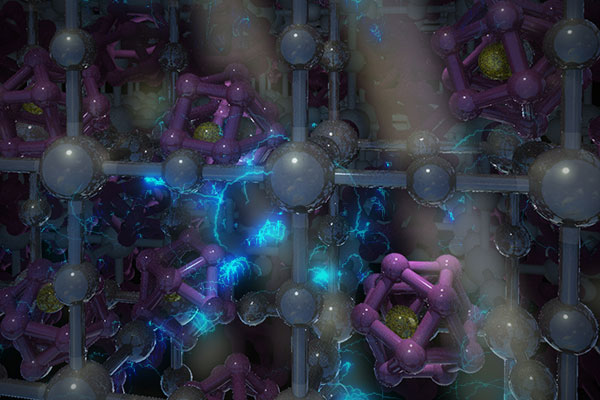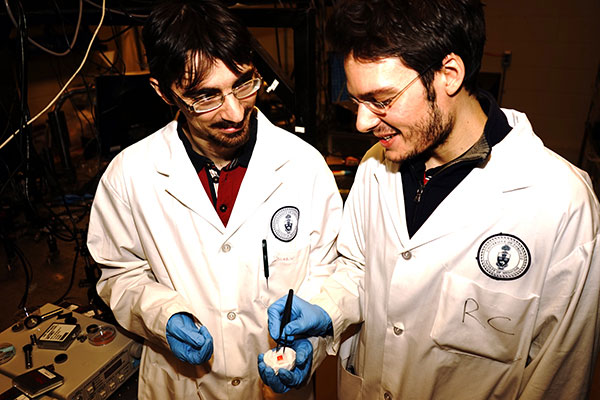Engineers are shining new light on an emerging family of solar-absorbing materials that could clear the way for cheaper and more efficient solar panels and LEDs.
The materials, called perovskites, are particularly good at absorbing visible light, but had never been studied in their purest form: as perfect single crystals.
Using a new technique, researchers grew large, pure perovskite crystals and studied how electrons move through the material as light is converted to electricity.
 Engineers are shining new light on an emerging family of solar-absorbing materials that could clear the way for cheaper and more efficient solar panels and LEDs (Photo: Marit Mitchell — University of Toronto).
Engineers are shining new light on an emerging family of solar-absorbing materials that could clear the way for cheaper and more efficient solar panels and LEDs (Photo: Marit Mitchell — University of Toronto).
 An artist’s rendering of perovskite crystal structure (Illustration: KAUST — University of Toronto).
An artist’s rendering of perovskite crystal structure (Illustration: KAUST — University of Toronto).
 Researchers Riccardo Comin and Valerio Adinolfi are working with Professor Ted Sargent of The Edward S. Rogers Sr. Department of Electrical & Computer Engineering (Photo: Marit Mitchell — University of Toronto).
Researchers Riccardo Comin and Valerio Adinolfi are working with Professor Ted Sargent of The Edward S. Rogers Sr. Department of Electrical & Computer Engineering (Photo: Marit Mitchell — University of Toronto).
Led by Professor Ted Sargent of The Edward S. Rogers Sr. Department of Electrical & Computer Engineering at the University of Toronto in collaboration with Professor Osman Bakr of the King Abdullah University of Science and Technology (KAUST), the team used a combination of laser-based techniques to measure selected properties of the perovskite crystals. By tracking down the ultrafast motion of electrons in the material, they have been able to measure the diffusion length—how far electrons can travel without getting trapped by imperfections in the material—as well as mobility—how fast the electrons can move through the material. Their work was published this week in the journal Science.
“Our work sets the bar for the ultimate solar energy-harvesting performance of perovskites,” says Riccardo Comin, a post-doctoral fellow with the Sargent Group. “With these materials it’s been a race to try to get record efficiencies, and there are no signs of stopping or slowing down.”
In recent years, perovskite efficiency has soared to over 20 per cent, very close to the current best performance of commercial-grade silicon-based solar panels you see mounted in Spanish deserts and on Californian roofs.
“In terms of efficiency, perovskites are perfectly comparable or better than materials that have already been commercialized,” says Valerio Adinolfi, a PhD candidate in the Sargent Group and co-first author on the paper. “The challenge is to make solar attractive from the business side. It’s not just matter of making it efficient—the point is to make it efficient and cheap.”
The study has obvious implications for green energy, but may also enable innovations in lighting. Think of a solar panel made of perovskite crystals as a fancy slab of glass: light hits the crystal surface and gets absorbed, exciting electrons in the material. Those electrons travel easily through the crystal to electrical contacts on its underside, where they are collected in the form of electric current. Now imagine the sequence in reverse—power the slab with electricity, inject electrons, and release energy as light. A more efficient electricity-to-light conversion means perovskites could open new frontiers for energy-efficient LEDs.
Parallel work in the Sargent Group focuses on improving nano-engineered solar-absorbing particles called colloidal quantum dots. “Perovskites are great visible-light harvesters, and quantum dots are great for infrared,” says Professor Sargent.
“In future, we will explore the opportunities for stacking together complementary absorbent materials,” says Dr. Comin. “There are very promising prospects for combining perovskite work and quantum dot work for further boosting the efficiency.”
References:
Publication: D. Shi, V. Adinolfi, R. Comin, M. Yuan, E. Alarousu, A. Buin, Y. Chen, S. Hoogland, A. Rothenberger, K. Katsiev, Y. Losovyj, X. Zhang, P. A. Dowben, O. F. Mohammed, E. H. Sargent, O. M. Bakr. Low trap-state density and long carrier diffusion in organolead trihalide perovskite single crystals. Science, 2015
Story Source: Crystal light: New family of light-converting materials points to cheaper, more efficient solar power and LEDs, University of Toronto — January 29, 2015













Comments